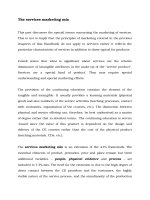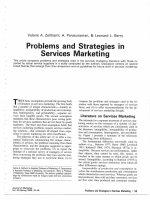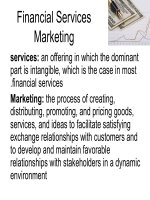Services marketing – crm
Bạn đang xem bản rút gọn của tài liệu. Xem và tải ngay bản đầy đủ của tài liệu tại đây (229.01 KB, 11 trang )
Services Marketing – CRM
CONTENT
1/ Explain the role and significance of services in the modem economy
What is the Service? Accordind to Philip Kotler “A service is any act or performance
one party can offer to another that is essentially intangible and does not result in the
ownership of anything. Its production may or may not be tied to a physical product.
Increasingly, manufacturers, distributors, and retailers are providing value-added
services, or simply excellent customer service, to differentiate themselves. Many pure
service firms are now using the Internet to reach customers; some are purely online”.
(Kotler, Philip 14th ed, p.355)
In today world, service is introduced by many forms. They almost respond people’s
demanded. For examples , sending mail, shopping,watching TV, calling by the
telephone, flighting by plane, catching a bus, seeing the dentists, doctors, posting a
letter, cutting a haircut, refueling a motor, surfing the internet , consulting, lawyering,
and etc are all of service consumption at the individual level.The service also included
forms such as electric and water supplying, hotels, restaurants, entertainments…
The world economy is increasingly characterized as a service economy. This is
primarily due to the increasing importance and share of the service sector in the
economies of most developed and developing countries. In fact, the growth of the
service sector has long been considered as an indicator of a country's economic
progress. Economic history tells us that all developing nations have invariably
experienced a shift from agriculture to industry and then to the service sector as the
mainstay of the economy. This shift has also brought about a change in the definition
of goods and services themselves.
Service organizations vary widely in size. At one end of the scale are huge
international corporations operating in such industries as airlines, banking, insurance,
telecommunications, and hotels. At the other end of the scale are a vast array of locally
owned and operated small businesses, such as restaurants, laundries, optometrists,
beauty parlors, and numerous business-to-business services.
The service sector is going through revolutionary change, which dramatically affects
the way in which we live and work. New services are continually being launched to
satisfy our existing needs and to meet needs that we did not even know we had. Nearly
fifty years ago, when the first electronic file sharing system was created, few people
likely anticipated the future demand for online banking, website hosting, or email
providers. Today, many of us feel we can't live without them. Similar transformations
are occurring in business-to-business markets.
The Role Of the Service Economy In Development
Accordind to report of People’s Committee Can tho City as of 2013, services
constituted over 52,47% of GDP in low income Can Tho City Vietnam. As their
economies continue to develop, the importance of the service sector continues to grow.
For instance, services accounted for 47% of economic growth in over the period
2000–2005, while industry only contributed 38,92% and agriculture only 8,6% in that
same period. This means that recent economic growth in Can Tho City Vietnam relied
as much on services as on natural resources or textiles, despite many of those City
benefiting from trade preferences in primary and secondary goods.
As a result of these changes, people are leaving the agricultural sector to find work in
the service economy. This job creation is particularly useful as often it provides
employment for unskilled workers in the tourism and retail sectors, which benefits the
poor and represents an overall net increase in employment. The service economy in
developing countries is most often made up of the following industries: financial
services, tourism, distribution, health, and education.
Summary, in the today world, knowledge economic is essential. It is so much
important that we can’t live without them.
2/ Answer the following:
a) The marketing planning process
Macdonald (1995) suggests that several stages have to be completed in order to arrive
at a strategic marketing plan. These are summarised in the diagram below:
The extent to which each part of the above process needs to be carried out depends on
the size and complexity of the business.
In a small or undiversified business, where senior management have a strong
knowledge and detailed understanding of the overall business, it may not be necessary
to formalise the marketing planning process.
By contrast, in a highly diversified business, top level management will not have
knowledge and expertise that matches subordinate management. In this situation, it
makes sense to put formal marketing planning procedures in place throughout the
organisation.
From the diagram, the main components of a marketing plan can be summarized
as:
Component of the plan Description
Mission statement A meaningful statement of the purpose and direction of the
Corporate objectives business
Marketing audit The overall business objectives that shape the marketing plan
The way the information for marketing planning is
Market analysis organised. Assesses the situation of marketing in the business
– the products, resources, distribution methods, market
shares, competitors etc
The markets the business is in (and targeting) – size ,
structure, growth etc
SWOT analysis An assessment of the firm’s current position, showing the
strengths & weaknesses (internal factors) and opportunities
and threats (external factors)
Marketing objectives What the marketing function wants to achieve (consistent
and strategies with corporate objectives) and how it intends to do it (e.g.
Ansoff, Porter)
Marketing budget Usually a detailed budget for the next year and an outline
budget for the next 2-3 years
Action plan The detailed implementation plan
b) Monitory marketing planning and services
Implementing and Monitoring Marketing Plans:The overall strategic marketing
plan serves as the basis for a series of operating plans necessary to move the
organization toward accomplishment of its objectives. At every step of the marketing
planning process, marketing managers use feedback to monitor and adapt strategies
when actual performance fails to match expectations.
4/ Answer the following:
a) Planning and branding service produccts
A product defines a consistent “bundle of output” and also the ability to differentiate
one bundle of output from another. (The statement, developed for tangible products, is
applicable for services).
Product lines and brands.
Mostly, companies operate several lines, changing the list given the changes in market
environment. (Marriott Corporation initially had: full-service business and resort
hotels, family and fast-food restaurant chains, contract food services (including both
institutional catering and in-flight kitchens and airlines), theme parks, and cruise ships.
Later, it sold most of the latter, expanding the first group.
British Airways had 8 brands under operation: Concorde, First Class, Club World
(business class), World Traveller (economy class); Club Europe and Euro-Traveler
(European business and economy); SuperShuttle brand (guaranteed economy seat at
high-frequency service); 6 commuter airlines (partnerships with BA), operating
British...
b) New service development
New service development concerns all the activities involved in realizing new service
opportunities, including product or service design, business model design, and
marketing.
When splitting service development into two parts, we have "service" and
"development. " The first things that come into mind when looking at service are:
economics, finance, managerial activities, competition, prices, and marketing. All of
these keywords are related to risk and entrepreneurship and clearly indicate the
primary scope of the term "service development. "
Development is very abstract and can be linked with some of the following keywords:
technological improvement, cost reduction, general welfare, improved relations, and
movement in a positive direction. Service development is mostly seen as growing an
enterprise through a number of techniques. The mentioned techniques differ, but in
fact all of them are about traditional marketing. The two main questions necessary to
this approach are: How do we find, reach, and approach customers? How do we keep
these customers satisfied with new possible services?
When supplying a solution, it is important to focus on the total offering you give
instead of only focusing on the product or service. An offering is a package consisting
of different proportions of a physical product, service, advice, delivery, and the costs.
Drawing on contingency theory, an idea central to new service development is that
different service, market, and technology combinations can require different marketing
strategies and business models to make them a success. To chart the factors that are
involved and create synergy between them, new service development draws heavily
upon the fields of technology and business networks. The new service development
process involves recognizing chances and opportunities in a fast changing
technological environment. For example, car manufacturers should recognize that
rising gas prices are an opportunity to create fuel efficient cars .
Innovative technology provides important opportunities for new service development.
For a company to stay competitive, it is important to keep services and processes up to
date. Continuous investment in innovation for both services and processes makes it
more difficult for others to gain a large technological functionality advantage.
Technological development can occur through making decisions about acquiring,
exploiting, and managing technologies. These decisions should be made by involving
the research and development staff, purchasing staff, and marketers.
5/ Write a detailed note on pricing strategies for services:
Pricing is one of the classic “4 Ps” of marketing (product, price, place, promotion). It’s
one of the key elements of every B2C strategy.
Yet for many B2B marketers, the pricing strategy in their marketing plan is
challenging to write; many aren’t even involved in creating their pricing strategy.
There are many factors to consider when developing your pricing strategy, both short-
and long-term. For example, your pricing needs to:
Reflect the value you provide versus your competitors
Match what the market will truly pay for your offering
Support your brand
Enable you to reach your revenue and market share goals
Maximize your profits
When you offer a truly unique product or service with little direct competition, it can
be challenging to establish your price. Define a strong strategy and competitive
analysis so you can view:
What your prospects might pay for other solutions to their problems
Where your price should fall in relation to theirs
When your price, value proposition and positioning are aligned, you’re in the best
situation to maximize revenue and profits.
6/ Answer the following:
a) Explain the role of marketing communication
Marketing communications is how you get your messages out to your
stakeholders; this includes all internal and external audiences. The foundation of
marketing communications is built on an understanding of what your different
stakeholders want to know; for example you might communicate the benefits of a
product to your customers and the sales figures to your shareholders.
Understanding your stakeholder’s needs and therefore the key messages comes from
your marketing communications plan (marcomm); but how are you going to reach
them? The best chance of successfully getting your audience to take the desired action
e.g. getting the customer to make a purchase, is to consider the DRIP analogy. DRIP
stands for differentiate, remind, inform and persuade and should be a blend of
messages delivered through a number of channels, over a period of time; this helps
keep the key messages memorable.
There are three communication strategies which are fully explained in the 3 P’s of
marketing communication, they are; Push, Pull and Profile. Within the Push and Pull
strategies you have above the line (ATL), below the line (BTL) and through the line
(TTL) communication channels; ATL & BTL are a way of categorising the
communication channels and are fully covered in our ATL & BTL article.
Here are some examples of communication channels:
- Personal selling
- Branding
- Sales promotions
- Public relations (PR)
- Merchandising
- Direct marketing
- Exhibitions
- Word of mouth
- Internal marketing
- Corporate image
- Packaging
- Sponsorship
- Advertising
Within each of these channels there are sub channels or tools, for example advertising
can consist of TV, Radio, Internet, Magazines, Cinema etc.
Without marketing communications your marketing plan and therefore business will
fail. As previously mentioned, it’s your marketing communications plan which maps
out the who, what, when, why and how.
b) Service promotion
Respondents were asked how they promote their services. The main strategies
for service promotion included participation in relevant networks, flyers, information
stalls, and websites. Media releases, advertisements in local print media, and
newsletters were less common. Further strategies included word of mouth and
promotion through other services, magazines, emails, the headspace initiative,
community education and health promotion, and education of generalist services (see
Table below).
Well-promoted services are likely to receive referrals from a range of other
organisations. Surveyed services reported receiving referrals from different sources
(see Table below). Seven services selected all referral sources listed in the table below.
There were no differences in the number of referral sources in regard to service size
and type.
One respondent noted that 'primary 'clients' are rural [regional] mental health
and drug and alcohol agencies and clinicians. I do provide primary and secondary
consultations around clients with complex co-occurring disorders but, when this
occurs, a secondary agenda is always to build the capacity of the referring clinicians or
agency to provide integrated treatment of co-occurring disorders'. Another respondent
stated that the majority of referrals are self-referrals.
The 17 services reported a wide range of different practices in regard to referral
processes and protocols, ranging from no protocols/processes other than the
requirement to be in a certain age range (youth service) to larger services with
different protocols/processes depending on the type of client or the referral source.
Four services reported minimal requirements for referral. Another four stated that they
have MOUs with some service providers. Several services reported using referral
forms (although these were not always used, and one service reported that this depends
on the clinician), and referrals via telephone, fax, and/or email. One service noted that
referrals sometimes are made through accompanying clients to appointments with
other services. Internal referrals occur via the electronic file management system,
intake meetings, and 'various teams'. One respondent suggested that 'eventually, ...
there will be large scale uptake of referrals through 'Connecting Care', an e-referral
system to health and community services in Victoria. This respondent also noted that
regional services are in the process of developing a 'NO Wrong Door multi agency
mental health and AOD protocol'.
The most commonly nominated referral sources were self-referral (n=14) and
the criminal justice system (n=11). Child care and financial counselling organisations
were not nominated as one of the three most common referral sources. See Table
below for more detail.
Table 01 : Service promotion
Type of service promotion Response frequency
Participation in relevant networks 15
Flyer(s) 14
Website 14
Information stalls at forums, 14
conferences etc.
Media releases 7
Advertisements in local print media 6
Newsletters 4
Table 02: Client recruitment
Client recruitment from Response frequency
Referral from AOD services 17
Referral from MH services 16
Referral from criminal justice system 16
Self-referral 15
Referral from family/friends/carers 15
Referral from primary health services (e.g. GP, 15
community health service)
Referral from welfare services 15
Referral from housing services 13
Referral from hospital 12
Referral from Centrelink 11
Table 03: The three most common referral sources
Referral source Response frequency AOD Response frequency
service combined service
1
Hospital 0 3
1
GP 1 2
Community health service 2
Housing/supported 1
accommodation
Employment 1 1
Centrelink 1 1
Child care 0 0
Financial counselling 0 0
AOD treatment service 2 3
MH service 0 5
Indigenous health service 1 1
Criminal justice system 9 2
Welfare 4 2
Self-referral 10 4
Family/ friends 0 1
Schools 1 1









